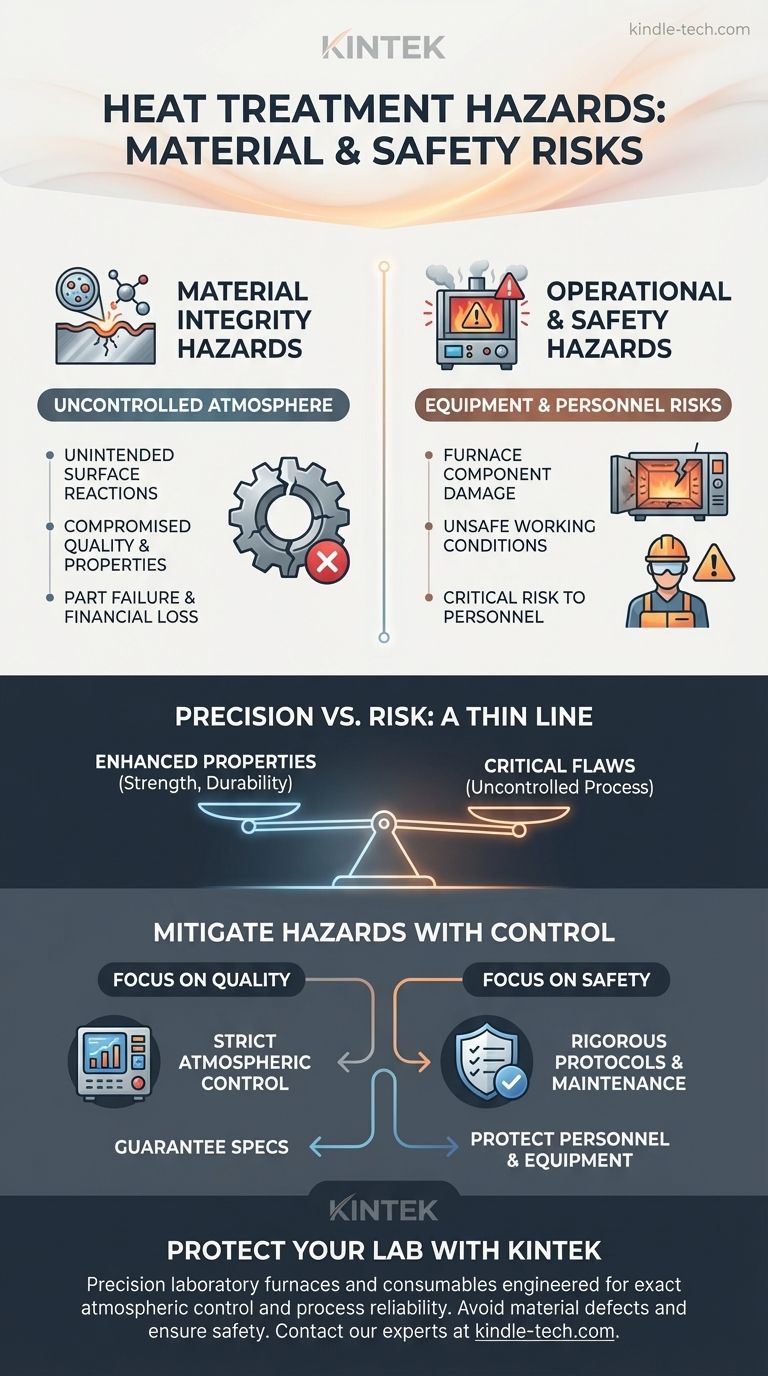The primary hazards of heat treatment fall into two distinct categories: risks to the material's integrity and risks to operational safety. An improperly controlled furnace atmosphere can cause unintended chemical reactions on a metal's surface, compromising its quality and leading to part failure, while also creating conditions that can damage equipment or, more critically, injure personnel.
The core danger in heat treatment is not the heat itself, but the failure to precisely control the process. This lack of control, particularly over the furnace atmosphere, transforms a value-adding process into one that can introduce catastrophic material defects and create significant safety risks.

Material Integrity Hazards: When the Process Fails the Part
Heat treatment is intended to enhance a material's properties, but any deviation from precise parameters can have the opposite effect. The environment inside the furnace is the most critical variable.
The Danger of an Uncontrolled Atmosphere
At elevated temperatures, metal surfaces become highly reactive. The specific gas mixture, or atmosphere, within the furnace is designed to facilitate the desired changes or protect the material from unwanted ones.
An improperly controlled atmosphere introduces reactive elements that can chemically alter the alloy's surface. This fundamentally changes the material from its engineered specifications.
The Consequences of Surface Reactions
These unwanted chemical reactions can compromise the quality, strength, and performance characteristics of the component. A part that was meant to be hardened could become brittle; one meant to be corrosion-resistant could be compromised.
The results are immediate and severe: rejected parts, wasted time, and significant financial loss. More dangerously, a part with undetected weakness can fail in its final application, creating a direct risk for the end-user.
Operational and Safety Hazards: Beyond the Material
The risks of a poorly controlled process extend beyond the part being treated. The operational environment itself can become hazardous.
Damage to Equipment
The same reactive atmosphere that damages the workpiece can also attack the furnace's internal components. This can lead to costly repairs, extended downtime, and a degradation of the equipment's ability to maintain precise control in the future.
Critical Risk to Personnel
The most severe hazard is the potential for employee injury. An improperly managed atmosphere can create unstable or dangerous conditions within the furnace, posing a direct threat to the safety of operators and technicians working in the vicinity.
Understanding the Trade-off: Precision vs. Risk
Heat treatment is an essential manufacturing process precisely because it can so dramatically improve a material's mechanical properties, from relieving stress to increasing strength and wear resistance.
The Goal of Enhancement
Manufacturers rely on heat treatment to make parts easier to machine, stronger in application, and more durable over their service life. It is a critical step for improving the performance of steels after processes like hot forming or welding.
The Inherent Risk
The trade-off is that this powerful process demands absolute precision. The line between imparting beneficial properties and creating a critical flaw is exceptionally thin. The entire process hinges on maintaining strict control, especially over the furnace atmosphere.
How to Mitigate Heat Treatment Hazards
Managing these hazards is not about avoiding heat treatment but about mastering the control of its environment. The focus must be on rigorous process validation and unwavering safety protocols.
- If your primary focus is product quality and performance: Implement and monitor strict atmospheric controls to prevent unintended surface reactions and guarantee the material's final mechanical properties meet design specifications.
- If your primary focus is operational safety: Enforce rigorous safety protocols and conduct regular furnace maintenance to protect personnel from harm and prevent costly equipment damage.
Ultimately, mastering the control of the heat treatment environment is the key to unlocking its powerful benefits while neutralizing its inherent risks.
Summary Table:
| Hazard Category | Key Risks | Primary Consequence |
|---|---|---|
| Material Integrity | Uncontrolled furnace atmosphere, unintended surface reactions | Part failure, compromised quality, financial loss |
| Operational Safety | Equipment damage, unsafe furnace conditions | Personnel injury, costly downtime, repair expenses |
Protect your lab from heat treatment hazards with KINTEK.
Our precision laboratory furnaces and consumables are engineered to deliver the exact atmospheric control and process reliability your operations demand. Avoid costly material defects and ensure operator safety with equipment designed for maximum performance and durability.
KINTEK specializes in lab equipment and consumables, serving all your laboratory needs. Let us help you mitigate risks and achieve superior results. Contact our experts today to discuss your specific heat treatment challenges and find the right solution for your lab.
Visual Guide

Related Products
- Vertical Laboratory Quartz Tube Furnace Tubular Furnace
- Vacuum Heat Treat Furnace and Levitation Induction Melting Furnace
- Graphite Vacuum Furnace High Thermal Conductivity Film Graphitization Furnace
- 2200 ℃ Tungsten Vacuum Heat Treat and Sintering Furnace
- Vacuum Heat Treat Furnace with Ceramic Fiber Liner
People Also Ask
- What is quartz tube heating? Achieve Instant, Targeted Heat with Infrared Radiation
- Why does heating increase temperature? Understanding the Molecular Dance of Energy Transfer
- What is the process of annealing tubes? Achieve Optimal Softness and Ductility for Your Tubing
- What is the standard thickness of plating? Optimize Durability, Corrosion & Cost
- How do you clean a quartz tube furnace? Prevent Contamination & Extend Tube Lifespan



















